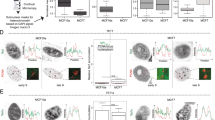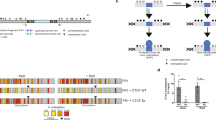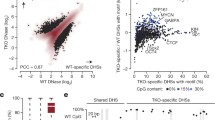Abstract
TET (ten-eleven translocation) enzymes initiate active cytosine demethylation via the oxidation of 5-methylcytosine. TET1 is composed of a C-terminal domain, which bears the catalytic activity of the enzyme, and a N-terminal region that is less well characterized except for the CXXC domain responsible for the targeting to CpG islands. While cytosine demethylation induced by TET1 promotes transcription, this protein also interacts with chromatin-regulating factors that rather silence this process, the coordination between these two opposite functions of TET1 being unclear. In the present work, we uncover a new function of the N-terminal part of the TET1 protein in the regulation of the chromatin architecture. This domain of the protein promotes the establishment of a compact chromatin architecture displaying reduced exchange rate of core histones and partial dissociation of the histone linker. This chromatin reorganization process, which does not rely on the CXXC domain, is associated with a global shutdown of transcription and an increase in heterochromatin-associated histone epigenetic marks. Based on these findings, we propose that the dense chromatin organization generated by the N-terminal domain of TET1 could contribute to restraining the transcription enhancement induced by the DNA demethylation activity of this enzyme.




Similar content being viewed by others
Data availability
The raw datasets used during the current study are available from the corresponding authors on reasonable request.
Code availability
Not applicable
References
Bancaud A, Huet S, Daigle N et al (2009) Molecular crowding affects diffusion and binding of nuclear proteins in heterochromatin and reveals the fractal organization of chromatin. EMBO J 28:3785–3798. https://doi.org/10.1038/emboj.2009.340
Bancaud A, Huet S, Rabut G, Ellenberg J (2010) Fluorescence perturbation techniques to study mobility and molecular dynamics of proteins in live cells: FRAP, photoactivation, photoconversion, and FLIP. Cold Spring Harb Protoc 2010:pdb.top90. https://doi.org/10.1101/pdb.top90
Bauer C, Göbel K, Nagaraj N et al (2015) Phosphorylation of TET proteins is regulated via O-GlcNAcylation by the O-Linked N-acetylglucosamine transferase (OGT). J Biol Chem 290:4801–4812. https://doi.org/10.1074/jbc.M114.605881
Bhutani N, Burns DM, Blau HM (2011) DNA demethylation dynamics. Cell 146:866–872. https://doi.org/10.1016/j.cell.2011.08.042
Bolte S, Cordelieres FP (2006) A guided tour into subcellular colocalization analysis in light microscopy. J Microsc 224:213–232. https://doi.org/10.1111/j.1365-2818.2006.01706.x
Cao R, Wang L, Wang H et al (2002) Role of histone H3 lysine 27 methylation in Polycomb-group silencing. Science 298:1039–1043. https://doi.org/10.1126/science.1076997
Fierz B, Poirier MG (2019) Biophysics of chromatin dynamics. Annu Rev Biophys 48:321–345. https://doi.org/10.1146/annurev-biophys-070317-032847
Frauer C, Rottach A, Meilinger D et al (2011) Different binding properties and function of CXXC zinc finger domains in Dnmt1 and Tet1. PLoS ONE 6:e16627. https://doi.org/10.1371/journal.pone.0016627
Funayama R, Saito M, Tanobe H, Ishikawa F (2006) Loss of linker histone H1 in cellular senescence. J Cell Biol 175:869–880. https://doi.org/10.1083/jcb.200604005
Good CR, Madzo J, Patel B et al (2017) A novel isoform of TET1 that lacks a CXXC domain is overexpressed in cancer. Nucleic Acids Res 45:8269–8281. https://doi.org/10.1093/nar/gkx435
Haralick RM, Shanmugam K, Dinstein I (1973) Textural features for image classification. IEEE Trans Syst Man Cybern 3:610–621. https://doi.org/10.1109/TSMC.1973.4309314
Hu L, Li Z, Cheng J et al (2013) Crystal structure of TET2-DNA complex: insight into TET-mediated 5mC oxidation. Cell 155:1545–1555. https://doi.org/10.1016/j.cell.2013.11.020
Iguchi-Ariga SM, Schaffner W (1989) CpG methylation of the cAMP-responsive enhancer/promoter sequence TGACGTCA abolishes specific factor binding as well as transcriptional activation. Genes Dev 3:612–619. https://doi.org/10.1101/gad.3.5.612
Ito S, Shen L, Dai Q et al (2011) Tet proteins can convert 5-methylcytosine to 5-formylcytosine and 5-carboxylcytosine. Science 333:1300–1303. https://doi.org/10.1126/science.1210597
Jin S-G, Zhang Z-M, Dunwell TL et al (2016) Tet3 reads 5-carboxylcytosine through Its CXXC domain and is a potential guardian against neurodegeneration. Cell Rep 14:493–505. https://doi.org/10.1016/j.celrep.2015.12.044
Lorsbach RB, Moore J, Mathew S et al (2003) TET1, a member of a novel protein family, is fused to MLL in acute myeloid leukemia containing the t(10;11)(q22;q23). Leukemia 17:637–641. https://doi.org/10.1038/sj.leu.2402834
Maiti A, Drohat AC (2011) Thymine DNA glycosylase can rapidly excise 5-formylcytosine and 5-carboxylcytosine: potential implications for active demethylation of CpG sites. J Biol Chem 286:35334–35338. https://doi.org/10.1074/jbc.C111.284620
Misteli T, Gunjan A, Hock R et al (2000) Dynamic binding of histone H1 to chromatin in living cells. Nature 408:877–881. https://doi.org/10.1038/35048610
Mulholland CB, Nishiyama A, Ryan J et al (2020) Recent evolution of a TET-controlled and DPPA3/STELLA-driven pathway of passive DNA demethylation in mammals. Nat Commun 11:5972. https://doi.org/10.1038/s41467-020-19603-1
Münzel M, Globisch D, Carell T (2011) 5-Hydroxymethylcytosine, the sixth base of the genome. Angew Chem Int Ed Engl 50:6460–6468. https://doi.org/10.1002/anie.201101547
Neri F, Incarnato D, Krepelova A et al (2015) TET1 is controlled by pluripotency-associated factors in ESCs and downmodulated by PRC2 in differentiated cells and tissues. Nucleic Acids Res 43:6814–6826. https://doi.org/10.1093/nar/gkv392
Neumann B, Walter T, Hériché J-K et al (2010) Phenotypic profiling of the human genome by time-lapse microscopy reveals cell division genes. Nature 464:721–727. https://doi.org/10.1038/nature08869
Ou HD, Phan S, Deerinck TJ, et al (2017) ChromEMT: visualizing 3D chromatin structure and compaction in interphase and mitotic cells. Science 357:. https://doi.org/10.1126/science.aag0025
Rasmussen KD, Helin K (2016) Role of TET enzymes in DNA methylation, development, and cancer. Genes Dev 30:733–750. https://doi.org/10.1101/gad.276568.115
Rausch C, Hastert FD, Cardoso MC (2019) DNA Modification readers and writers and their interplay. J Mol Biol. https://doi.org/10.1016/j.jmb.2019.12.018
Rother MB, Pellegrino S, Smith R et al (2020) CHD7 and 53BP1 regulate distinct pathways for the re-ligation of DNA double-strand breaks. Nat Commun 11:5775. https://doi.org/10.1038/s41467-020-19502-5
Shi F-T, Kim H, Lu W et al (2013) Ten-eleven translocation 1 (Tet1) is regulated by O-linked N-acetylglucosamine transferase (Ogt) for target gene repression in mouse embryonic stem cells. J Biol Chem 288:20776–20784. https://doi.org/10.1074/jbc.M113.460386
Tahiliani M, Koh KP, Shen Y et al (2009) Conversion of 5-methylcytosine to 5-hydroxymethylcytosine in mammalian DNA by MLL partner TET1. Science 324:930–935. https://doi.org/10.1126/science.1170116
Talbert PB, Henikoff S (2017) Histone variants on the move: substrates for chromatin dynamics. Nat Rev Mol Cell Biol 18:115–126. https://doi.org/10.1038/nrm.2016.148
Watt F, Molloy PL (1988) Cytosine methylation prevents binding to DNA of a HeLa cell transcription factor required for optimal expression of the adenovirus major late promoter. Genes Dev 2:1136–1143. https://doi.org/10.1101/gad.2.9.1136
Wiles ET, Selker EU (2017) H3K27 methylation: a promiscuous repressive chromatin mark. Curr Opin Genet Dev 43:31–37. https://doi.org/10.1016/j.gde.2016.11.001
Willcockson MA, Healton SE, Weiss CN et al (2021) H1 histones control the epigenetic landscape by local chromatin compaction. Nature 589:293–298. https://doi.org/10.1038/s41586-020-3032-z
Wu H, D’Alessio AC, Ito S et al (2011) Dual functions of Tet1 in transcriptional regulation in mouse embryonic stem cells. Nature 473:389–393. https://doi.org/10.1038/nature09934
Zhang W, Xia W, Wang Q et al (2016) Isoform switch of TET1 regulates DNA demethylation and mouse development. Mol Cell 64:1062–1073. https://doi.org/10.1016/j.molcel.2016.10.030
Zhong J, Li X, Cai W et al (2017) TET1 modulates H4K16 acetylation by controlling auto-acetylation of hMOF to affect gene regulation and DNA repair function. Nucleic Acids Res 45:672–684. https://doi.org/10.1093/nar/gkw919
Acknowledgements
We thank the engineers of the Microscopy Rennes Imaging Center (BIOSIT, Université Rennes 1), Stéphanie Dutertre and Xavier Pinson for technical help on the microscopes. We are also grateful to the engineers of the flow cytometry facility (BIOSIT, Université Rennes 1), Laurent Deleurme and Alexis Aimé for technical assistance. This work would not have been possible without the generous donation of plasmids from Heinrich Leonhardt, Cristina Cardoso, Wei Xie, Haico Van Attikum, Gyula Timinszky, and Jan Ellenberg.
Funding
This work was funded by the Ligue contre le Cancer du Grand-Ouest, the Conseil Régional de Bretagne and the Institut Universitaire de France. The Microscopy-Rennes Imaging Center (BIOSIT, Université Rennes 1), is a member of the national infrastructure France-BioImaging supported by the French National Research Agency (ANR-10-INBS-04).
Author information
Authors and Affiliations
Contributions
A.L., S.Z., S.H., and R.S. completed the experiments within the manuscript. C.C. generated cell lines and DNA constructs. A.L., S.Z., S.H., and O.D.A. performed data analysis. G.S. and S.H. conceived and supervised this study. S.H. wrote the manuscript. All authors read and commented on the manuscript.
Corresponding authors
Ethics declarations
Ethics approval and consent to participate
Not applicable
Consent for publication
Not applicable
Competing interests
The authors declare no competing interests.
Additional information
Publisher's note
Springer Nature remains neutral with regard to jurisdictional claims in published maps and institutional affiliations.
Supplementary Information
Below is the link to the electronic supplementary material.
Supplementary Figure 1
. Controls of the changes in chromatin compaction state upon expression of unfused GFP and GFP-TET1. a. Images of U2OS cells stained with Hoechst as well as an anti-dsDNA antibody, and expressing either unfused GFP (GFP) or full-length (GFPTET1). Cells were fixed and stained 24 h after transfection. More than 30 cells were imaged per condition and a typical image is shown for each. b. Timelapse image sequence of live U2OS cells stably expressing H2B-mCherry and transiently expressing unfused GFP. The images were pseudocolored according to the look-up table displayed below the images. The timelapse acquisition started 6 h after transfection c. Images from a. were quantified to monitor the changes in GFP expression levels (black curve), assessed by GFP fluorescence intensity, in parallel to the chromatin spatial distribution, assessed by the fluorescence contrast estimated from the images of the H2B-mCherry signal (red curve). The curves show a mean ± SD of 11 cells. Before averaging, the individual curves for the chromatin contrast and the expression level were aligned in time using as a reference the timepoint at which the normalized expression level equalled 0.5. The time was then estimated relative to this reference timepoint. For panels a. and b., scale bars = 10 μm
Supplementary Figure 2. Influence of the N-terminal and C-terminal domains of TET1 on the levels of 5-hmC and the chromatin patterns. a. Images of Hoechst-stained UO2S cells expressing either unfused GFP, full-length TET1 (GFP-FL), the C-terminal domain of TET1 (CTER-GFP) or the N-terminal domain of TET1 (NTER-GFP), all tagged with GFP. The cells were also immunostained for 5-hmC. Cells were fixed and stained 24 h after transfection. More than 30 cells were imaged per condition and a typical image is shown for each. Scale bars = 10 μm. b. Scatter plot of the mean nuclear intensity of the 5hmC staining plotted as a function of the mean nuclear signal in the GFP channel measured from the cells shown in a. c. Scatter plot of the fluorescence contrast, estimated from the Hoechst staining, plotted against the mean nuclear GFP signal measured from the images of U2OS cells expressing GFP-tagged full-length or the N-terminal domain of TET1, which are shown on figure 2b. The correlation between the contrast and the GFP signal was estimated by calculating the Spearman coefficient. The dotted line correponds to the linear fit of the experimental points. d. The colocalisation between the Hoechst and GFP stainings in U2OS cells expressing GFP-tagged full-length or the N-terminal domain of TET1 was estimated by calculating the Pearson coefficient between the two channels on the images shown on figure 2a
Supplementary Figure 3. Analysis of EU and H3K27me3 staining in cells expressing fulllength or the N-terminal domain of TET1. a. The colocalization between the Hoechst and EU staining on the images shown on figure 4a was estimated by calculating the Pearson coefficient between the two channels b. Gating strategy for the analysis of EU and H3K27me3 staining by flow cytometry. The first gate was performed on the scatter plot of SSC-A against FSC-A to select living cells (right). The second gate was applied to the scatter plot of SSC-A against SSC-H to remove cell doublets (middle). Finally, the scatter plot of the EU or H3K27me3 signals against the GFP signal (FITC-A::GFP) was analyzed (left). Gates for cells negative for GFP (GFP-) or negative for EU or H3K27me3 staining were established based on the signals obtained for U2OS cells that were not subjected to transfection and EU or H3K27me3 staining. Finally, the GFP positive cells (PDF 1796 KB)
Rights and permissions
About this article
Cite this article
Lejart, A., Zentout, S., Chapuis, C. et al. The N-terminal domain of TET1 promotes the formation of dense chromatin regions refractory to transcription. Chromosoma 131, 47–58 (2022). https://doi.org/10.1007/s00412-022-00769-0
Received:
Revised:
Accepted:
Published:
Issue Date:
DOI: https://doi.org/10.1007/s00412-022-00769-0




